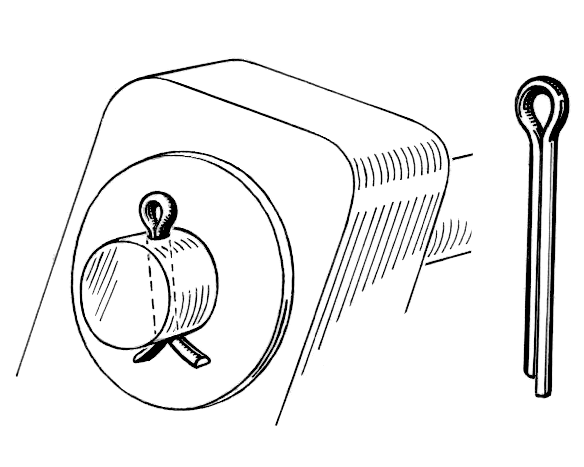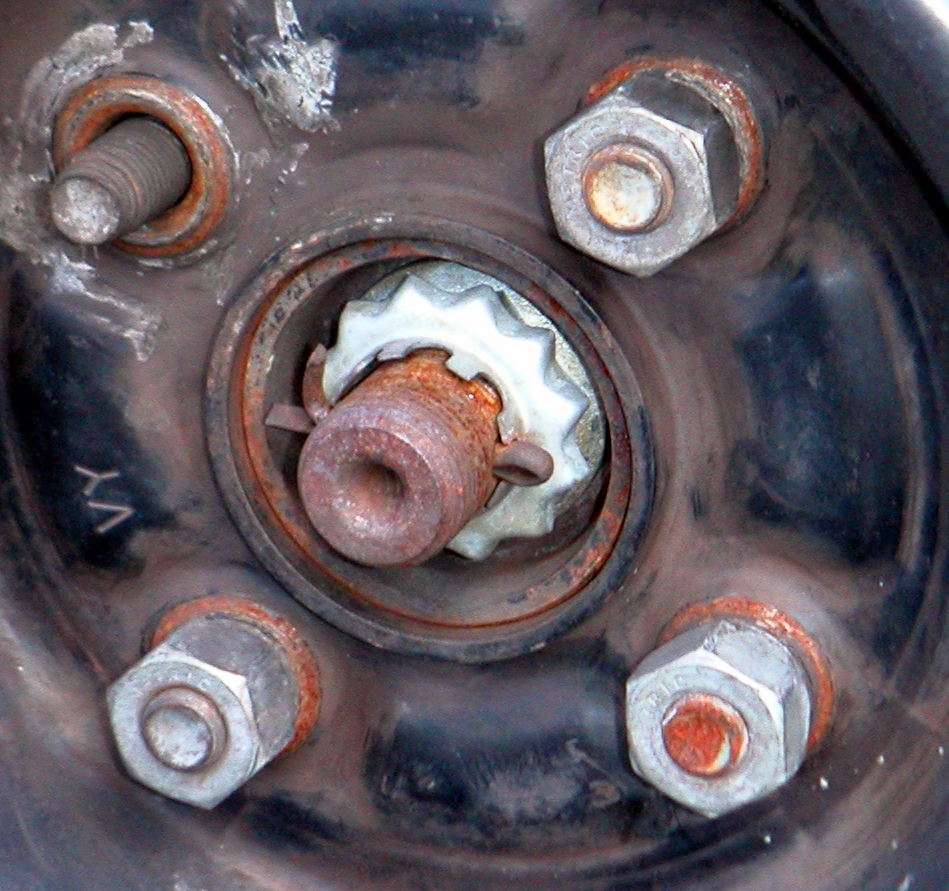Split Pin on:
[Wikipedia]
[Google]
[Amazon]
 A split pin, also known in the
A split pin, also known in the
 A new split pin (see figure A) has its flat inner surfaces touching for most of its length so that it appears to be a split cylinder (figure D). Once inserted, the two ends of the pin are bent apart, locking it in place (figure B). When they are removed they are supposed to be discarded and replaced, because of fatigue from bending.
Split pins are typically made of soft metal, making them easy to install and remove, but also making it inadvisable to use them to resist strong shear forces. Common materials include mild steel,
A new split pin (see figure A) has its flat inner surfaces touching for most of its length so that it appears to be a split cylinder (figure D). Once inserted, the two ends of the pin are bent apart, locking it in place (figure B). When they are removed they are supposed to be discarded and replaced, because of fatigue from bending.
Split pins are typically made of soft metal, making them easy to install and remove, but also making it inadvisable to use them to resist strong shear forces. Common materials include mild steel,
 The most common type of split pin is the extended prong with a square cut, but extended prongs are available with all of the other types of ends. The extended prong type is popular because the difference in length of the two tines makes it easier to separate them. To ease insertion into a hole the longer tine may be slightly curved to overlap the tip of the shorter tine or it is beveled.
''Hammer lock'' split pins are properly installed by striking the head with a hammer to secure the pin. This forces the shorter tine forward, spreading the pin..
Types include ''standard'', ''humped'' and ''clinch''.
The most common type of split pin is the extended prong with a square cut, but extended prongs are available with all of the other types of ends. The extended prong type is popular because the difference in length of the two tines makes it easier to separate them. To ease insertion into a hole the longer tine may be slightly curved to overlap the tip of the shorter tine or it is beveled.
''Hammer lock'' split pins are properly installed by striking the head with a hammer to secure the pin. This forces the shorter tine forward, spreading the pin..
Types include ''standard'', ''humped'' and ''clinch''.
 Split pins are frequently used to secure other fasteners, e.g.
Split pins are frequently used to secure other fasteners, e.g.
 A split pin, also known in the
A split pin, also known in the United States of America
The United States of America (U.S.A. or USA), commonly known as the United States (U.S. or US) or America, is a country primarily located in North America. It consists of 50 states, a federal district, five major unincorporated territo ...
as a cotter pin or cotter key, is a metal fastener
A fastener (US English) or fastening (UK English) is a hardware device that mechanically joins or affixes two or more objects together. In general, fasteners are used to create non-permanent joints; that is, joints that can be removed or disman ...
with two tines
Tines (; also spelled tynes), prongs or teeth are parallel or branching spikes forming parts of a tool or natural object. They are used to spear, hook, move or otherwise act on other objects. They may be made of metal, wood, bone or other hard, ...
that are bent during installation, similar to a staple or rivet
A rivet is a permanent mechanical fastener. Before being installed, a rivet consists of a smooth cylindrical shaft with a head on one end. The end opposite to the head is called the ''tail''. On installation, the rivet is placed in a punched ...
. Typically made of thick wire
Overhead power cabling. The conductor consists of seven strands of steel (centre, high tensile strength), surrounded by four outer layers of aluminium (high conductivity). Sample diameter 40 mm
A wire is a flexible strand of metal.
Wire is c ...
with a half-circular cross section, split pins come in multiple sizes and types.
The British definition of "cotter pin" is equivalent to U.S. term " cotter". To avoid confusion, the term split cotter is sometimes used for a split pin. A further use of the term "cotter pin" is the "crank cotter pin" used to lock bicycle pedal cranks to the bottom bracket axle. These are not "split" at all and are wedge shaped.
Construction
brass
Brass is an alloy of copper (Cu) and zinc (Zn), in proportions which can be varied to achieve different mechanical, electrical, and chemical properties. It is a substitutional alloy: atoms of the two constituents may replace each other wit ...
, bronze, stainless steel
Stainless steel is an alloy of iron that is resistant to rusting and corrosion. It contains at least 11% chromium and may contain elements such as carbon, other nonmetals and metals to obtain other desired properties. Stainless steel's corros ...
, and aluminium
Aluminium (aluminum in American and Canadian English) is a chemical element with the symbol Al and atomic number 13. Aluminium has a density lower than those of other common metals, at approximately one third that of steel. I ...
..
Types
Sizes
The diameters of split pins are standardized. American split pins start at in and end at in. Metric conversions in the table below are approximate.Applications
 Split pins are frequently used to secure other fasteners, e.g.
Split pins are frequently used to secure other fasteners, e.g. clevis pin
A clevis fastener is a two-piece fastener system consisting of a ''clevis'' and a ''clevis pin head''. The clevis is a U-shaped piece that has holes at the end of the prongs to accept the clevis pin. The clevis pin is similar to a bolt, but is ...
s, as well as being used in combination with hardboard
Hardboard, also called high-density fiberboard (HDF), is a type of fiberboard, which is an engineered wood product. It is used in furniture and in the construction industry.
Description
Hardboard is similar to particle board and medium-densi ...
discs as a traditional joining technique for teddy bear
A teddy bear is a stuffed toy in the form of a bear. Developed apparently simultaneously by toymakers Morris Michtom in the U.S. and Richard Steiff under his aunt Margarete Steiff's company in Germany in the early 20th century, the teddy b ...
s. A common application of this is when used to secure a castellated nut
A castellated nut, sometimes referred to as a castle nut, is a nut with slots (notches) cut into one end.
The name comes from the nut’s resemblance to the crenellated parapet of a medieval castle. Castellated nuts are sometimes referred to i ...
. .
Split pins may be used in some applications as low-tech shear pin {{unreferenced, date=September 2018
A shear pin is a mechanical detail designed to allow a specific outcome to occur once a predetermined force is applied. It can either function as a safeguard designed to break to protect other parts, or as a con ...
s.
See also
*Circle cotter
A circle cotter, also known as a cotter ring or split ring, is a formed wire
Overhead power cabling. The conductor consists of seven strands of steel (centre, high tensile strength), surrounded by four outer layers of aluminium (high cond ...
* Hairpin clip
A hairpin clip, also known as a retaining pin, is a type of formed wire used on a grooved shaft. It is designed to be easily installed and uninstalled, and is reusable. They are commonly made from 1050 carbon steel and 300 series stainless steel ...
* Linchpin
A linchpin, also spelled linch pin, lynchpin, or lynch pin, is a fastener used to prevent a wheel or other part from sliding off the axle upon which it is riding. The word is first attested in the late fourteenth century and derives from Mid ...
* R-clip
__NOTOC__
An R-clip, also known as an R-pin, R-key, hairpin cotter pin, hairpin cotter,. bridge pin, hitch pin clip or spring cotter pin, is a fastener made of a durable but flexible material, commonly hardened metal wire, resembling the shape of ...
* Spring pin
A spring pin (also called tension pin or roll pin) is a mechanical fastener that secures the position of two or more parts of a machine relative to each other. Spring pins have a body diameter which is larger than the hole diameter, and a chamf ...
References
Notes Bibliography *. *. *. *.External links
*{{Commonscat-inline, Split cotter pins Fasteners Mechanical fasteners Metallic objects